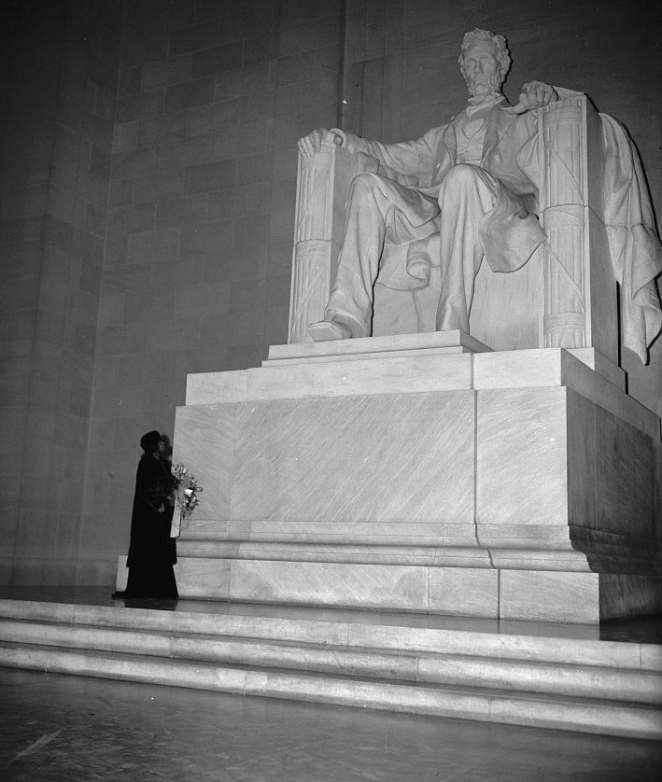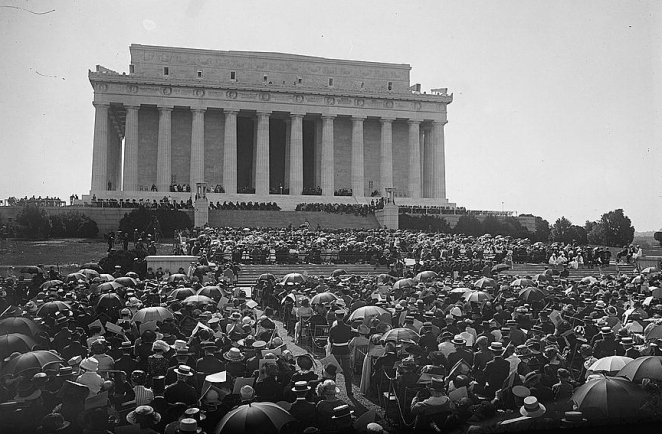
America’s great contralto, Marian Anderson, stands before Lincoln’s statue on the day of her triumphant concert at the Lincoln Memorial, April 9, 1939. (U.S. Library of Congress, public domain.)
“I am humbled to be a part of honoring this great man and preserving this iconic memorial for future generations.” – David Rubenstein
On Presidents’ Day 2016, Americans were greeted by the news that one of their most cherished national symbols will be preserved for their grandchildren and great-grandchildren via a multi-million dollar renovation of the Lincoln Memorial. The tender loving care will be funded by an $18.5 million donation from philanthropist and Carlyle Group co-founder David Rubenstein, and will include the memorial’s cleaning, repairs to marble masonry and brick, and conservation of the spectacular Jules Guérin murals which help bring Abraham Lincoln’s ideals to life for the millions of women, men and children who visit America’s National Mall annually.
In addition, an elevator will be installed to improve access for visitors with disabilities, and more space will be made available for exhibits, education and research.
“These improvements will hopefully enable more people to better understand and appreciate Abraham Lincoln’s remarkable leadership during one of the most trying periods in American history,” David Rubenstein said. “I am humbled to be a part of honoring this great man and preserving this iconic memorial for future generations.”
The much-needed support comes as the U.S. National Park Service celebrates its Centennial Anniversary, and is the fourth such gift to the NPS by Rubenstein and one of many others he has made to history museums across America. In January, he loaned two rare copies of the Emancipation Proclamation and 13th Amendment to the Smithsonian Institution’s new National Museum of African American History and Culture, and also gifted $10 million to the NMAAHC. In 2015 and 2014, he donated $5.4 million and roughly $12.4 million, respectively, for renovations to the U.S. Marine Corps War Memorial and Arlington House on the grounds of Arlington National Cemetery.
“In this temple, as in the hearts of the people for whom he saved the Union, the memory of Abraham Lincoln is enshrined forever.”
Those words inscribed above Lincoln’s statue eloquently describe the experience of visitors to the Lincoln Memorial, and were penned by Royal Cortissoz, an art critic and columnist for the New York Herald Tribune. The statue, designed by sculptor Daniel Chester French and carved by the Piccirilli Brothers from 1918-1920, is a towering 19 feet high and depicts Lincoln seated and musing in the midst of America’s great Civil War, his left hand clenched forcefully in recognition of the fight being waged by his beloved nation, his right resting on the arm of his chair as if signaling his hope that peace was still possible. Those hands are so mesmerizing because French not only studied photographs of Lincoln’s face prior to beginning his design work, he studied castings of Lincoln’s actual hands which had been created in 1860.
French’s protégé, Evelyn Beatrice Longman, fashioned the decorative carvings adorning Lincoln’s Gettysburg Address and Second Inaugural Address while Ernest C. Bairstow carved the lettering in the Lincoln Memorial’s interior and the eagles, festoons and wreaths on the building’s exterior.
Henry Bacon designed not just the architecture of the Greek Doric-style building where Lincoln’s statue is housed, but the memorial’s overall “effect.” It was Bacon, a New York architect, who chose Jules Guérin to create the interior murals, Emancipation and Unity, which bring Abraham Lincoln’s ideals to life.
Bacon also ensured that it would be uniquely “American,” by using Alabama marble for the ceiling, granite from Massachusetts for the terrace, Colorado marble for the upper steps and façade, pink marble from Tennessee for the interior chamber floors, Indiana limestone for the columns and interior walls. The Great Emancipator’s likeness was hewn from Georgia marble.
Construction began in 1914; the memorial was officially dedicated in 1922.

Dedication of the Lincoln Memorial, Washington, D.C., 30 May 1922. (U.S. Library of Congress, public domain.)
Truly Iconic in a World of Faux Icons
Although the word iconic has been misapplied in today’s media to everything and everyone from fad fashions to one-hit wonders, it is a word which does truly befit the Lincoln Memorial, which has served as the gathering point Americans during critical periods in the nation’s history.
It was here, on Easter Sunday in 1939 at the urging of First Lady Eleanor Roosevelt, that Marian Anderson sang for the nation when the Daughters of the American Revolution refused to allow America’s great contralto to sing before an integrated audience at the DAR’s Constitution Hall.
And it was here, on August 28, 1863, that the Rev. Dr. Martin Luther King, Jr. inspired generations to fight for a world in which children would “not be judged by the color of their skin but by the content of their character.”
Rubenstein, in giving this particular gift to the National Park Foundation, has reinvigorated the words of Abraham Lincoln, who said during his 1863 Gettysburg Address:
“Four score and seven years ago our fathers brought forth on this continent, a new nation, conceived in Liberty, and dedicated to the proposition that all men are created equal.
Now we are engaged in a great civil war, testing whether that nation, or any nation so conceived and so dedicated, can long endure. We are met on a great battle-field of that war. We have come to dedicate a portion of that field, as a final resting place for those who here gave their lives that that nation might live. It is altogether fitting and proper that we should do this.
But, in a larger sense, we can not dedicate — we can not consecrate — we can not hallow — this ground. The brave men, living and dead, who struggled here, have consecrated it, far above our poor power to add or detract. The world will little note, nor long remember what we say here, but it can never forget what they did here. It is for us the living, rather, to be dedicated here to the unfinished work which they who fought here have thus far so nobly advanced. It is rather for us to be here dedicated to the great task remaining before us — that from these honored dead we take increased devotion to that cause for which they gave the last full measure of devotion — that we here highly resolve that these dead shall not have died in vain — that this nation, under God, shall have a new birth of freedom — and that government of the people, by the people, for the people, shall not perish from the earth.”
Said U.S. Secretary of the Interior Sally Jewell of Rubenstein’s generosity, “His act of ‘patriotic philanthropy’ will not only safeguard one of our most visited and recognizable memorials for future generations, but will also help preserve Lincoln’s legacy to this country.”
Image (top): America’s great contralto, Marian Anderson, stands before Abraham Lincoln’s statue on the day of her most triumphant performance, April 9, 1939. Refused permission by the Daughters of the American Revolution to sing for an integrated audience at the DAR’s Constitution Hall, she was invited by President Franklin D. Roosevelt and First Lady Eleanor Roosevelt to perform at the National Mall. An estimated crowd of 75,000 witnessed Anderson make history at the Lincoln Memorial while millions tuned in via radio that Easter Sunday, 1939. (U.S. Library of Congress, public domain.)

You must be logged in to post a comment.